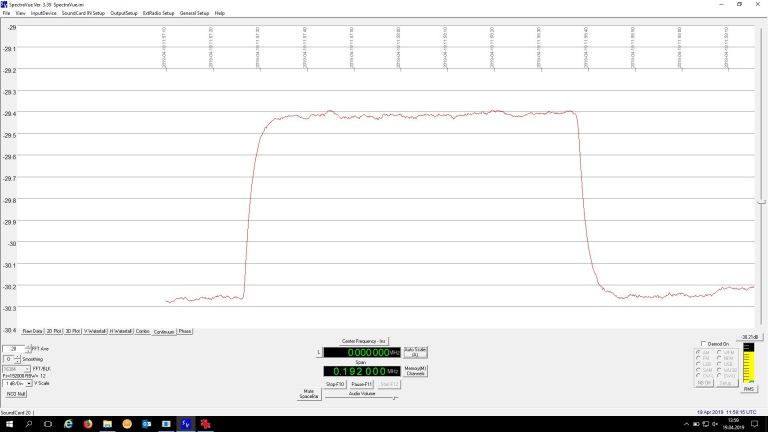Sun noise, hot/cold measurements, ...
Sun noise measurements and ground-sky measurements of receivers/transverters with and without an antenna (dish, horn)
are extremely useful to determine overall system performance. Especially at higher GHz bands because cheap noise sources are very rare at these
frequencies. Click HERE, download and extract my Excel sheet "Earth-Space-Attenuation" to calculate microwave earth-space attenuation up to 1000 GHz.
Calculation of atmospheric attenuation (ITU-R P.676-12) is included.
At 10 GHz sun noise depends mainly on sun activity.
At 47 GHz and higher sun noise depends mainly on atmospheric attenuation due to water vapour/O2 (weather condition and sun elevation), ratio of sun diameter and half power beam width.
ATTENTION !
At these frequencies (>47 GHz) and already at moderate dish sizes the -3dB half power beam width is in the region of
sun diameter (0.5°). That means that the sun is an extended source, not a point source. Be extremely careful if this happens because all information about
calculations/formulas in the internet, publications, radio astronomy books, ... mainly requires point sources.
16th of February 2019: Talk "Sun Noise measurements in the upper GHz bands" at Dorsten GHz
conference in Germany
Click here (only available in German) -->

15th of February 2020: Talk "Determination of receiver noise figure and antenna efficiency in the upper GHz bands" at Dorsten GHz conference in Germany
Click here (only available in German) -->

EARTH-SPACE ATTENUATION:
1. Theory of noise measurements
See more detailed explanations in my presentation above.


2. Equipment
Software: Spectravue
Hardware: Funcube dongle pro+
Lenovo Convertible Miix 320 Tablet PC (10.1" touch screen), Win10 and only 0.56 kg
3. Some results of different measuring methods
GROUND (hot) - SKY (cold):
As shown above under "theory" the easiest way is to hold the transverter with the feed opening in the direction of trees. Tree temperature is your ambient temperatur and therefore
it is a "hot" measurement. Determine the power with e.g. a Funcube dongle pro+ and Spectravue (continuum mode).
For a cold measurement hold your feed opening to the zenith (cold sky). Again determine the power.
It is very tricky to get accurate hot ground and cold sky measurements, especially using whole feed/dish system.
Important is :
- hot ground: Don't use wet surface or electrically conductive ground. This promotes reflections, e.g. from the sky. Use trees instead.
- cold sky: Due to spill over (feed looks next to dish rim) additional noise is received. How much, that depends on feed side lobes and background of the dish.
Don't use trees, house walls, RF absorber, ... behind a dish. Ideally use a flat ground (very low horizon) or an electrically conductive ground (mesh) or an electrically conductive shield around/behind the dish.
MICROWAVE ABSORBER (hot) - SKY (cold):
A better methode is to use a microwve absorber plate (e.g. Eccosorb HR-25) for the hot measurement.
The transverter feed points into the zenith - make a cold sky measurement - then hold the absorber plate in front of the feed opening
(distance should be around 30-50 mm for microwave) - make a hot absorber measurement.
Don't forget to use correct absorber temperature as it is black and will also absorb heat.


GROUND (microwave absorber) - LIQUID NITROGEN LN2:
The styrofoam box is filled with microwave absorber Eccosorb HR-25 and liquid nitrogen at 77 Kelvin.
Point to the warm microwave absorber (e.g. room temperature) with the transverter feed. Make a power measurement. Then point into the cold liquid nitrogen and again make a
power measurement.



SKY DIPS:
Example of a sky dips measurement at 76 GHz.
Use a cloud free, sunny, blue sky day. Point the dish to a cloud free region apart from the sun. Then make power measurements at different elevations.
For more information about calculation see Joachim Köppen DF3GJ in DUBUS 1/2016 p.70-81



SUN NOISE:
Example of a sun noise measurement at 76 GHz.
Use a cloud free, sunny, blue sky day. Point the dish directly to the sun and find the maximum/hot power signal (adjust elevation and azimuth). Then move the dish some degrees to
the right or left and you will get the minimum/cold power signal.
To find the sun (elevation, azimuth) I use suncalc.

4. Noise figure of sat TV LNB smaller than 0.1 dB ?!?
Nowadays nearly all LNB (low noise block) manufacturers claim a noise figure better than 0.1 dB. Is that possible? Of course NO!
Do not believe in these marketing promises!
The best preamplifier chip has around 0.35 dB at 11-12 GHz and the whole circuit is always worse than this 0.35 dB. Why then 0.1 dB? It sounds better and they use a trick.
Noise figure is measured at around 290 K (17°C). If we cool down the preamplifier chip then the noise figure is better. If we use liquid nitrogen at 77 Kelvin then we have around 0.1 dB for the chip.
But in reality the whole LNB has more than 0.35 dB and therefore more than 0.1 dB at 77 K. So this 0.1 dB is very theoretical and nobody has a liquid nitrogen cooled LNB.
